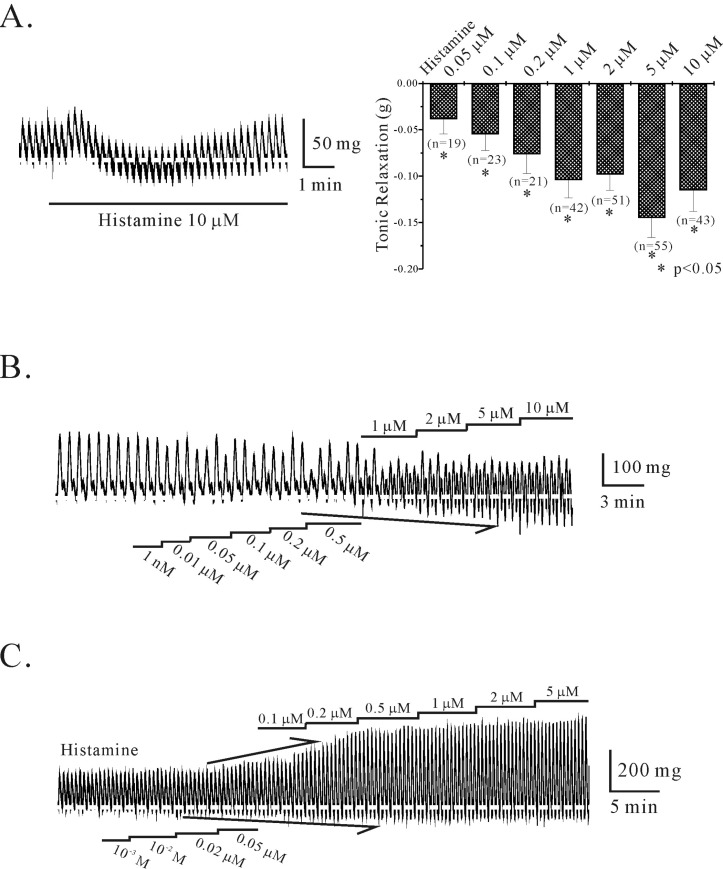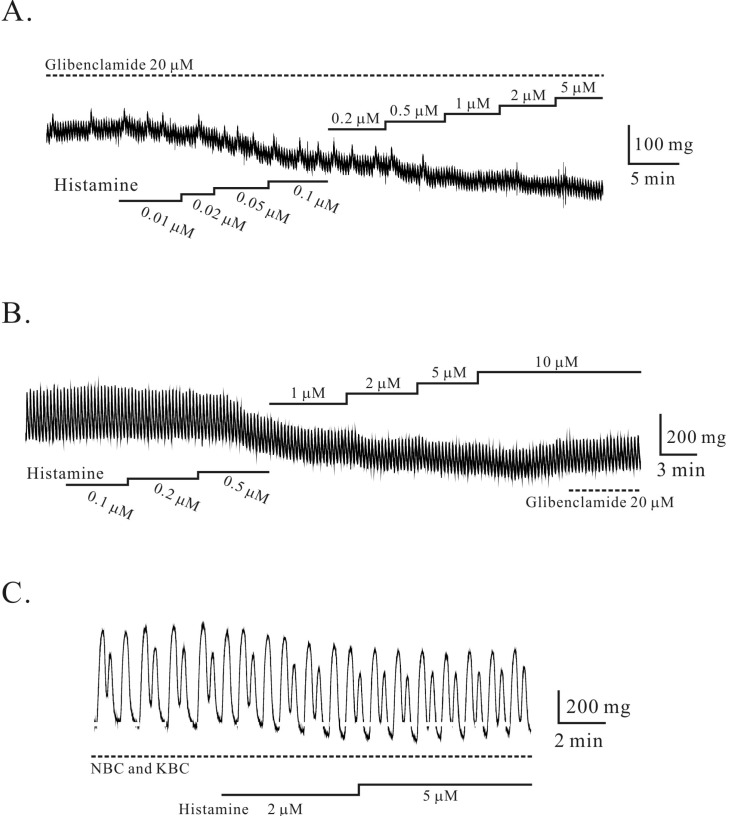1. Dy M, Schneider E. Histamine-cytokine connection in immunity and hematopoiesis. Cytokine Growth Factor Rev. 2004; 15:393–410. PMID:
15450254.

2. Rangachari PK. The fate of released histamine: reception, response and termination. Yale J Biol Med. 1998; 71:173–182. PMID:
10461350.
3. Shahid M, Tripathi T, Sobia F, Moin S, Siddiqui M, Khan RA. Histamine, histamine receptors, and their role in immunomodulation: an updated systematic review. Open Immunol J. 2009; 2:9–41.

4. Hill SJ. Distribution, properties, and functional characteristics of three classes of histamine receptor. Pharmacol Rev. 1990; 42:45–83. PMID:
2164693.
5. Parsons ME, Ganellin CR. Histamine and its receptors. Br J Pharmacol. 2006; 147(Suppl 1):S127–S135. PMID:
16402096.

6. Stark H. Histamine receptors. Biotrend Rev. 2007; 1:1–6.
7. Muller MJ, Prior T, Hunt RH, Rangachari PK. H
1 contractile and H
2 relaxant receptors in canine gastric muscularis mucosae. Life Sci. 1993; 52:PL49–PL53. PMID:
8429755.
8. Ohga A, Taneike T. H
1- and H
2-receptors in the smooth muscle of the ruminant stomach. Br J Pharmacol. 1978; 62:333–337. PMID:
638312.
9. Kim H, Dwyer L, Song JH, Martin-Cano FE, Bahney J, Peri L, Britton FC, Sanders KM, Koh SD. Identification of histamine receptors and effects of histamine on murine and simian colonic excitability. Neurogastroenterol Motil. 2011; 23:949–e409. PMID:
21806740.

10. Kim YC, Choi W, Yun HY, Sung R, Yoo RY, Park SM, Yun SJ, Kim MJ, Song YJ, Xu WX, Lee SJ. Nitric oxide-mediated relaxation by high K
+ in human gastric longitudinal smooth muscle. Korean J Physiol Pharmacol. 2011; 15:405–413. PMID:
22359479.
11. Kim DH, Kim YC, Choi W, Yun HY, Sung R, Kim HS, Kim H, Yoo RY, Park SM, Yun SJ, Song YJ, Xu WX, Lee SJ. High K
+-induced relaxation by nitric oxide in human gastric fundus. Korean J Physiol Pharmacol. 2012; 16:297–303. PMID:
23118553.
12. Kim YC, Choi W, Sung R, Kim H, You RY, Park SM, Youn SJ, Kim MJ, Song YJ, Xu WX, Lee SJ, Yun HY. Relaxation patterns of human gastric corporal smooth muscle by cyclic nucleotides producing agents. Korean J Physiol Pharmacol. 2009; 13:503–510. PMID:
20054499.

13. Yun HY, Sung R, Kim YC, Choi W, Kim HS, Kim H, Lee GJ, You RY, Park SM, Yun SJ, Kim MJ, Kim WS, Song YJ, Xu WX, Lee SJ. Regional distribution of interstitial cells of cajal (ICC) in human stomach. Korean J Physiol Pharmacol. 2010; 14:317–324. PMID:
21165331.

14. Gokina NI, Bevan JA. Histamine-induced depolarization: ionic mechanisms and role in sustained contraction of rabbit cerebral arteries. Am J Physiol Heart Circ Physiol. 2000; 278:H2094–H2104. PMID:
10843909.
15. Gokina NI, Bevan JA. Role of intracellular Ca
2+ release in histamine-induced depolarization in rabbit middle cerebral artery. Am J Physiol Heart Circ Physiol. 2000; 278:H2105–H2214. PMID:
10843910.
16. Kim YC, Sim JH, Kang TM, Suzuki H, Kim SR, Kwon SC, Xu WX, Lee SJ, Kim KW. Sodium-activated potassium current in guinea pig gastric myocytes. J Korean Med Sci. 2007; 22:57–62. PMID:
17297252.

17. Park JK, Kim YC, Sim JH, Choi MY, Choi W, Hwang KK, Cho MC, Kim KW, Lim SW, Lee SJ. Regulation of membrane excitability by intracellular pH (pHi) changers through Ca
2+-activated K
+ current (BK channel) in single smooth muscle cells from rabbit basilar artery. Pflugers Arch. 2007; 454:307–319. PMID:
17285302.
18. Cardell LO, Edvinsson L. Characterization of the histamine receptors in the guinea-pig lung: evidence for relaxant histamine H3 receptors in the trachea. Br J Pharmacol. 1994; 111:445–454. PMID:
7911715.

19. Bolton TB. Mechanisms of action of transmitters and other substances on smooth muscle. Physiol Rev. 1979; 59:606–718. PMID:
37533.

20. Karashima T, Kuriyama H. Electrical properties of smooth muscle cell membrane and neuromuscular transmission in the guinea-pig basilar artery. Br J Pharmacol. 1981; 74:495–504. PMID:
6274466.

21. Sander LE, Lorentz A, Sellge G, Coëffier M, Neipp M, Veres T, Frieling T, Meier PN, Manns MP, Bischoff SC. Selective expression of histamine receptors H1R, H2R, and H4R, but not H3R, in the human intestinal tract. Gut. 2006; 55:498–504. PMID:
16299042.

22. Diaz J, Vizuete ML, Traiffort E, Arrang JM, Ruat M, Schwartz JC. Localization of the histamine H
2 receptor and gene transcripts in rat stomach: back to parietal cells. Biochem Biophys Res Commun. 1994; 198:1195–1202. PMID:
8117277.
23. Lovenberg TW, Pyati J, Chang H, Wilson SJ, Erlander MG. Cloning of rat histamine H(3) receptor reveals distinct species pharmacological profiles. J Pharmacol Exp Ther. 2000; 293:771–778. PMID:
10869375.
24. Oda T, Morikawa N, Saito Y, Masuho Y, Matsumoto S. Molecular cloning and characterization of a novel type of histamine receptor preferentially expressed in leukocytes. J Biol Chem. 2000; 275:36781–36786. PMID:
10973974.

25. Bytzer P. H
2 receptor antagonists and prokinetics in dyspepsia: a critical review. Gut. 2002; 50:iv58–iv62. PMID:
11953351.
26. Yu YC, Guo HS, Li Y, Piao L, Li L, Li ZL, Xu WX. Role of calcium mobilization in sodium nitroprusside-induced increase of calcium-activated potassium currents in gastric antral circular myocytes of guinea pig. Acta Pharmacol Sin. 2003; 24:819–825. PMID:
12904283.
27. Ibba Manneschi L, Pacini S, Corsani L, Bechi P, Faussone-Pellegrini MS. Interstitital cells of Cajal in the human stomach: distribution and relationship with enteric innervation. Histol Histopathol. 2004; 19:1153–1164. PMID:
15375758.
28. Tonini M, De Giorgio R, De Ponti F, Sternini C, Spelta V, Dionigi P, Barbara G, Stanghellini V, Corinaldesi R. Role of nitric oxide- and vasoactive intestinal polypeptide-containing neurones in human gastric fundus strip relaxations. Br J Pharmacol. 2000; 129:12–20. PMID:
10694197.

29. Iino S, Horiguchi K, Nojyo Y. Interstitial cells of Cajal are innervated by nitrergic nerves and express nitric oxide-sensitive guanylate cyclase in the guinea-pig gastrointestinal tract. Neuroscience. 2008; 152:437–448. PMID:
18280665.

30. Kim YC, Suzuki H, Xu WX, Choi W, Kim SH, Lee SJ. Ca
2+-activated K
+ current in freshly isolated c-Kit positive cells in guinea-pig stomach. J Korean Med Sci. 2009; 24:384–391. PMID:
19543421.
31. Kim YC, Suzuki H, Xu WX, Hashitani H, Choi W, Yun HY, Park SM, Youn SJ, Lee SJ, Lee SJ. Voltage-dependent Ca current identified in freshly isolated interstitial cells of cajal (ICC) of guinea-pig stomach. Korean J Physiol Pharmacol. 2008; 12:323–330. PMID:
19967074.
32. Nemeth L, Puri P. Three-dimensional morphology of c-Kit-positive cellular network and nitrergic innervation in the human gut. Arch Pathol Lab Med. 2001; 125:899–904. PMID:
11419974.

33. Sung R, Kim YC, Yun HY, Choi W, Kim HS, Kim H, Lee KJ, You RY, Park SM, Youn SJ, Kim MJ, Kim WS, Song YJ, Kim SY, Xu WX, Lee SJ. Interstitial cells of Cajal (ICC)-like-c-Kit positive cells are involved in gastritis and carcinogenesis in human stomach. Oncol Rep. 2011; 26:33–42. PMID:
21573494.









 PDF
PDF ePub
ePub Citation
Citation Print
Print


 XML Download
XML Download